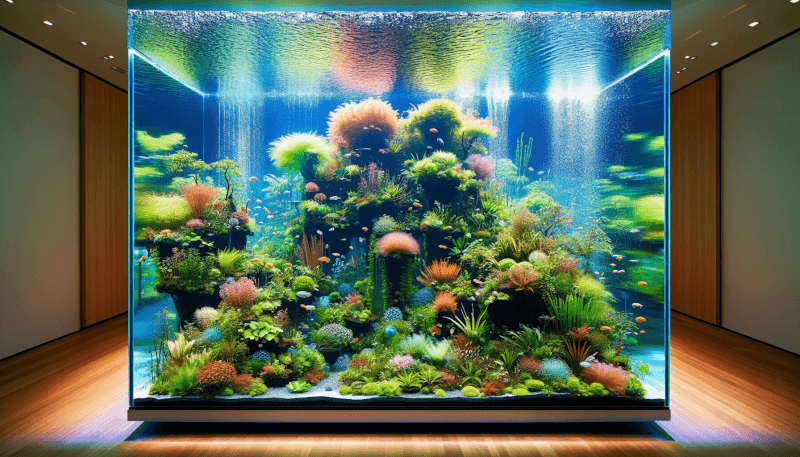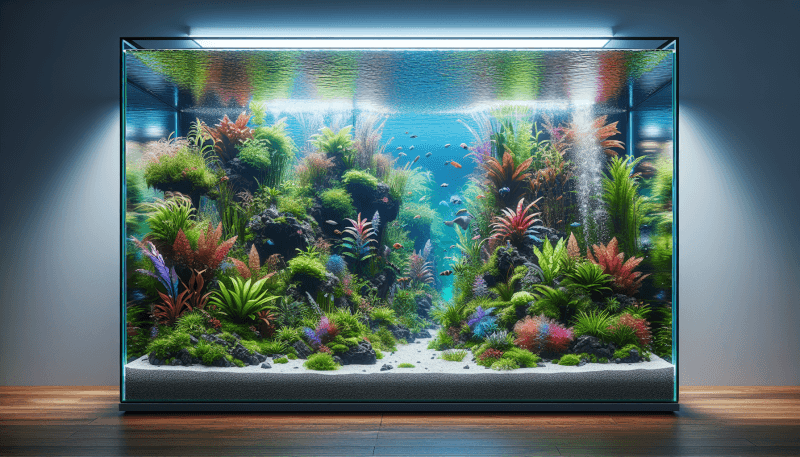When it comes to creating a visually stunning aquarium, the right substrate can make all the difference. Whether you’re aiming for a vibrant underwater landscape or a natural habitat for your fish, selecting the right substrate is crucial. From gravel and sand to specialized substrates like clay and soil, each option offers unique benefits and considerations. In this article, we will explore the various factors to consider when choosing the perfect substrate for your aquarium aesthetics, ensuring you can create a captivating underwater world that leaves both you and your fish in awe.
Understanding the Importance of Substrate in Aquarium Aesthetics
When it comes to creating a visually appealing aquarium, the importance of substrate cannot be understated. Not only does it provide a natural environment for your fish, but it also serves as a solid foundation for aquatic plants. Additionally, the choice of substrate can greatly enhance the overall visual appeal and color contrast of your aquarium. Furthermore, substrate plays a crucial role in promoting biological filtration, which is vital for maintaining a healthy and balanced ecosystem within your aquarium.
Factors to Consider When Choosing Aquarium Substrate
Before diving into the different types of substrate available, it’s important to consider certain factors that will help you make an informed decision. Firstly, you need to take into account the compatibility of your fish and plants with the chosen substrate. Each species has its own specific needs and preferences, so selecting a substrate that suits their requirements is crucial.
Next, consider the size and depth of your tank. The amount of substrate needed may vary depending on the size of your aquarium, and the depth can also impact the functionality and aesthetics of the substrate. Additionally, take into account the water parameters and pH level required by your fish and plants. Some species thrive in specific water conditions, so choosing a substrate that aligns with these requirements is essential.
Ease of maintenance is another important factor to consider. Some substrates require more frequent cleaning and vacuuming, while others are relatively low-maintenance. Consider the amount of time and effort you are willing to devote to substrate maintenance before making a decision. Lastly, consider your budget and the overall cost of the chosen substrate. Remember, you don’t have to break the bank to achieve a beautiful aquarium setup.

Types of Substrate for Aquarium
There are several types of substrate available for aquariums, each with its own unique qualities and benefits. Gravel is a popular choice due to its affordability, availability, and ease of maintenance. It comes in a variety of colors and sizes, allowing you to create various aesthetic effects. Sand is another common option, especially for tanks with bottom-dwelling species. It provides a natural look and feel, and can be easily cleaned using a gravel vacuum.
Marbles and pebbles are ideal for aquariums with specific design themes or for adding decorative elements. They are available in various colors and sizes, allowing you to add a personal touch to your aquarium. Aquatic soil is a nutrient-rich option primarily used in planted aquariums. It provides a fertile environment for plant roots and promotes healthy growth. Additionally, substrate mats can be used to create a leveled and uniform surface.
For dedicated planted aquariums, plant-specific substrates are available. These substrates are specially formulated to provide the necessary nutrients for plants to thrive. They often contain fertilizers that promote healthy and vibrant growth. Consider the specific needs of your aquatic plants to determine the most suitable substrate for your tank.
Choosing Substrate for Fish-Only Aquariums
When selecting substrate for fish-only aquariums, there are a few key considerations to keep in mind. Firstly, consider the desired aesthetic effect you want to achieve. Gravel comes in a variety of sizes and colors, allowing you to create a visually appealing setup that suits your taste. Avoid sharp or abrasive substrates that may harm your fish. Smooth gravel or sand is a safer option.
Additionally, consider the behavior and habitat of your fish. Some species are bottom-dwellers and prefer sandy substrates that allow them to sift through the substrate in search of food. Others may prefer a mix of gravel and sand to mimic their natural environment. Adding decorative elements such as rocks, driftwood, or artificial plants can further enhance the aesthetics of a fish-only aquarium.
Selecting Substrate for Planted Aquariums
Planted aquariums require careful consideration when it comes to substrate selection. Rooted plants benefit from fine substrates that allow their roots to easily penetrate and establish themselves. Consider using a substrate specifically designed for planted aquariums, as they often contain the necessary nutrients and minerals for optimal plant growth.
Layering different substrate types can also be beneficial in a planted aquarium. For example, a layer of nutrient-rich soil can be covered with a layer of gravel or sand to create a visually appealing and functional substrate. Additionally, consider using capped substrates to prevent nutrient leaching. This involves placing a layer of inert material, such as sand or gravel, on top of the nutrient-rich substrate to prevent the release of excess nutrients into the water column.
Creating Aquascape with Substrate
Utilizing substrate to create an attractive aquascape is a crucial aspect of aquarium design. Start by designing the hardscape layout using rocks, driftwood, or other decor elements. Place these items before adding the substrate to ensure a natural and balanced arrangement. Consider the contours and slopes of the substrate, as they can create depth and visual interest in your aquascape.
Dividing your tank into zones using substrate is another effective technique for creating an appealing aquascape. By varying the height or type of substrate in different areas of the tank, you can create distinct sections or highlight specific plants and decor. This can greatly enhance the overall visual appeal and provide a sense of depth to your aquarium.
For theme-based aquascapes, incorporating substrate that aligns with your chosen theme is essential. For example, a sandy substrate can create a beach-like environment, while a gravel substrate in earth tones can mimic a riverbed or natural stream. Use your creativity and imagination to design a unique and captivating aquascape that reflects your personal style.

Benefits of Biological Filtration with Substrate
One significant benefit of using substrate in your aquarium is its role in promoting biological filtration. Substrate provides a surface area for beneficial bacteria to colonize, which helps break down harmful ammonia and nitrate compounds. These bacteria convert these compounds into less toxic substances, contributing to improved water quality and clarity.
By promoting the growth of beneficial bacteria, substrate helps establish a stable and balanced ecosystem within your aquarium. This is especially important for maintaining the health and well-being of your fish and plants. A well-established biological filtration system helps reduce the levels of ammonia and nitrate, which are harmful to aquatic life in high concentrations.
Maintaining and Cleaning Substrate
Proper maintenance and cleaning of aquarium substrate are essential for the health and longevity of your aquarium. Regular vacuuming and debris removal are important to prevent the accumulation of waste and detritus in the substrate. This can help maintain water quality and prevent the buildup of harmful compounds.
Avoid overusing chemical cleaners, as they can disrupt the delicate balance of the aquarium ecosystem. Instead, opt for manual cleaning methods such as using a gravel vacuum or gently stirring the substrate to dislodge any trapped debris. Regular water changes can also help maintain optimal water quality and prevent the accumulation of excess nutrients.
In case of contamination or severe substrate deterioration, it may be necessary to replace the substrate. This should be done with caution, as the process can disrupt the balance of the aquarium. Ensure proper rinsing and preparation of the new substrate before introducing it into the tank. Monitor water parameters closely during and after substrate replacement to ensure the health and stability of the aquarium.

Tips for Balancing Aesthetics and Practicality
When selecting and using substrate in your aquarium, it’s important to find a balance between aesthetics and practicality. Consider the behavior and natural habitat of your fish when choosing substrate types. Some species may require specific substrate conditions to thrive, so take these factors into account.
Experiment with different substrate depths to create visual interest and provide varying habitats for your fish and plants. By utilizing different depths, you can create a layered effect in your aquarium and provide hiding spots or feeding areas for your aquatic pets.
Mixing substrate colors can also greatly enhance the visual appeal of your aquarium. Try combining different shades of gravel or sand to create a more dynamic and visually striking setup. Be creative and don’t be afraid to think outside the box when it comes to substrate aesthetics.
Finally, take inspiration from natural aquatic environments. Studying the habitats of fish and plants in the wild can provide valuable insights when designing your aquarium. Consider replicating the substrate characteristics, plant arrangements, and hardscape layouts found in their natural habitats to create a more natural and harmonious environment.
Conclusion
Choosing the right substrate for your aquarium is a crucial step in creating a visually appealing and functional setup. Consider the needs and preferences of your fish and plants, as well as the overall aesthetic effect you want to achieve. Take into account factors such as compatibility, tank size, water parameters, and ease of maintenance. Use substrate to create a captivating aquascape by designing hardscape layouts, utilizing different substrate types, and dividing your tank into zones. Remember the benefits of biological filtration and maintain your substrate properly to ensure a healthy and balanced ecosystem. By considering these factors and following these tips, you can create a stunning aquarium that provides a natural and inviting environment for your aquatic pets.


